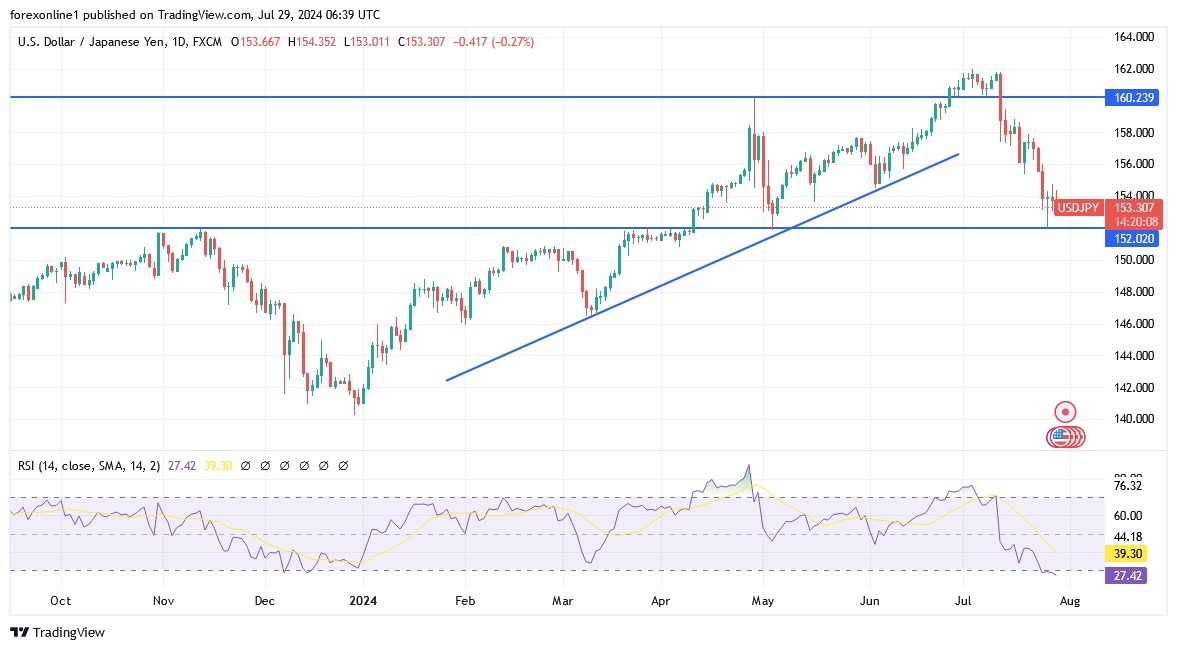- This week, the USD/JPY will experience significant volatility due to the policy announcements from both the US Federal Reserve and the Bank of Japan.
- Recently, speculation about a potential rate hike by the Bank of Japan has led to strong and sharp selling of USD/JPY, driving it to the support level of 151.94 last week, the lowest in over two months.
- Recently, the pair closed the week around 153.73.

According to the latest economic calendar results, the US economy grew at a strong annual rate of 2.8% in the last quarter, driven by consumer and business spending despite ongoing high-interest rate pressures. The report issued by the Department of Commerce last Thursday stated that the gross domestic product - the economy's total output of goods and services - rose in the April-June quarter after growing at a rate of 1.4% in the January-March period. Economists had forecast a weaker annual growth rate of 1.9%.
Also, the GDP report showed inflation continuing to ease, while remaining above the Federal Reserve’s 2% target. The central bank’s preferred measure of inflation rose at a 2.6% annual rate in the fourth quarter, down from 3.4% in the first quarter. Furthermore, excluding volatile food and energy prices, so-called core personal consumption expenditures (PCE) inflation rose at a 2.9% rate. That was down from 3.7% in January-March.
Overall, the latest figures should bolster confidence that the U.S. economy is on the cusp of a rare “soft landing,” in which higher interest rates engineered by the Fed tame inflation without tipping the economy into recession. Consumer spending, the heart of the U.S. economy, powered the expansion last quarter. Moreover, it rose at a 2.3% annual rate in the April-June quarter, down from a 1.5% rate in January-March.
For their part, Federal Reserve officials have made clear that with inflation nearing their 2% target, they are prepared to start cutting interest rates soon, something they are widely expected to do in September. Overall, the state of the economy has captured Americans’ attention as the presidential campaign intensifies. Although inflation has slowed sharply, to 3% from 9.1% in 2022, rates remain well above pre-pandemic levels. The economic slowdown this year largely reflects much higher borrowing rates for home loans, auto loans, credit cards and many business loans resulting from a series of aggressive interest rate hikes by the Fed. The Fed’s rate hikes — 11 in 2022 and 2023 — were a response to a surge in inflation that began in the spring of 2021 as the economy rebounded unexpectedly quickly from the Covid-19 recession, causing severe supply shortages. Russia’s invasion of Ukraine in February 2022 has exacerbated matters by inflating the prices of energy and grains that the world relies on. As a result, prices have risen across the country and the world.
Top Forex Brokers
This week, the US Federal Reserve is expected to keep the federal funds rate steady at 5.25%-5.50% for an eighth straight meeting, but all eyes will be on any indication of the central bank’s plans for September, with a rate cut fully in the cards. The US economy is likely to have added 185,000 jobs this month, down from 206,000 in June, while the unemployment rate is likely to remain at a 2021 high of 4.1% and wage growth is expected to be 0.3%. Additionally, the ISM Purchasing Managers’ Index is expected to show that the manufacturing sector remained in contraction for a third month.
Meanwhile,other key indicators to watch include the JOLTS report, ADP employment numbers, Challenger job cuts, S&P Global Manufacturing PMI Final, S&P/Case-Shiller Home Price Index, FHFA Home Prices, CB Consumer Confidence, Nonfarm Productivity, Labor Costs, and Factory Orders. Additionally, traders will be paying close attention to the quarterly payrolls announcement to assess the federal government’s borrowing requirements and upcoming strategies for securities and bond sales.
Finally, earnings season will continue with reports from major companies Microsoft, Apple, Amazon, and Meta, along with McDonalds, P&G, Merck, Toyota, AMD, Caterpillar, Pfizer, S&P Global, Stryker, Airbus, Mastercard, T-Mobile, Qualcomm, HSBC, Boeing, Intel, Exxon Mobil, Chevron, and Linde.
In Japan, financial markets still Favor keeping the Bank of Japan’s interest rate at 0.1%, but bets on a hike gained strong momentum last week, as well as the possibility of halving the pace of Japanese government bond purchases. Other key Japanese data include July consumer confidence, unemployment rate, retail sales, industrial production, and housing starts for June.
USD/JPY Technical Analysis and Expectations Today
Based on the performance on the daily chart below, the USD/JPY price path has turned bearish and the next most important target for further bear control of the trend is the psychological support level of 150.00. With its break, technical indicators will move towards strong oversold levels. On the other hand, with the break of the resistance of 156.60, bulls will gain momentum to return to the upward movement.
Want to trade our USD/JPY forex analysis and predictions? Here's a list of forex brokers in Japan to check out.
